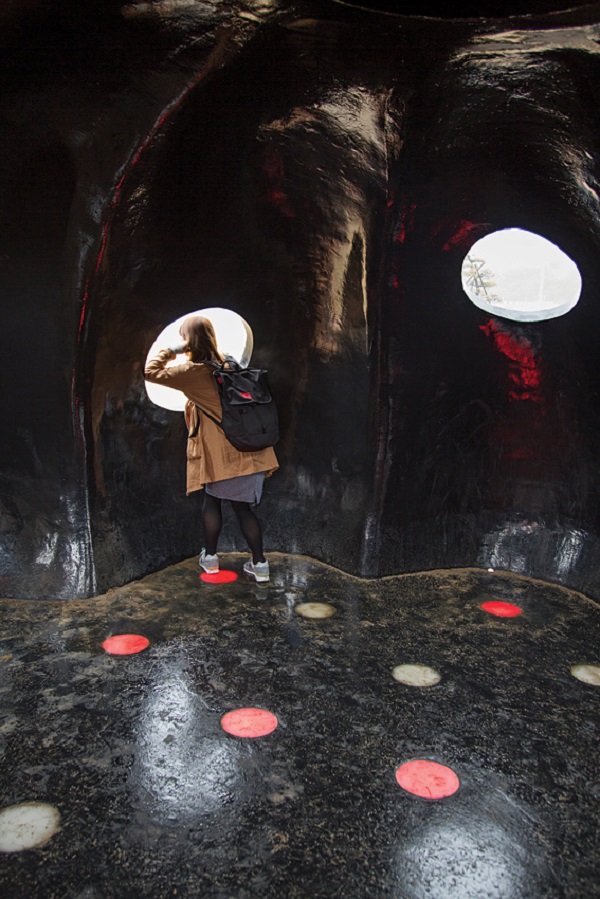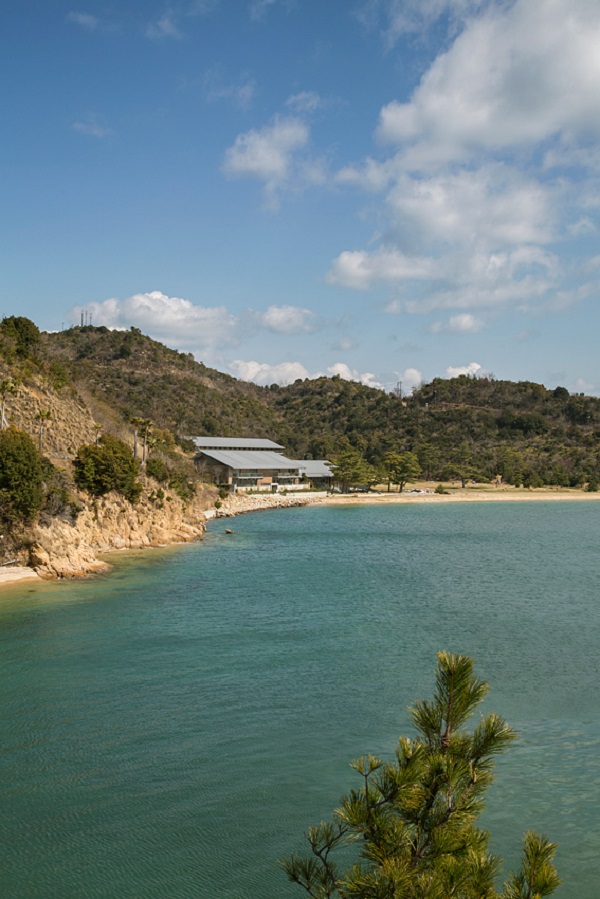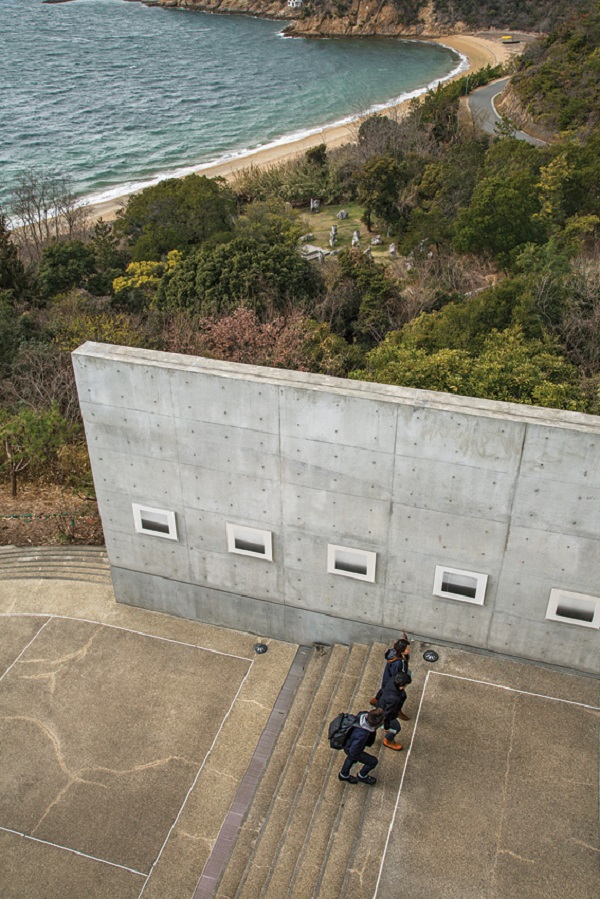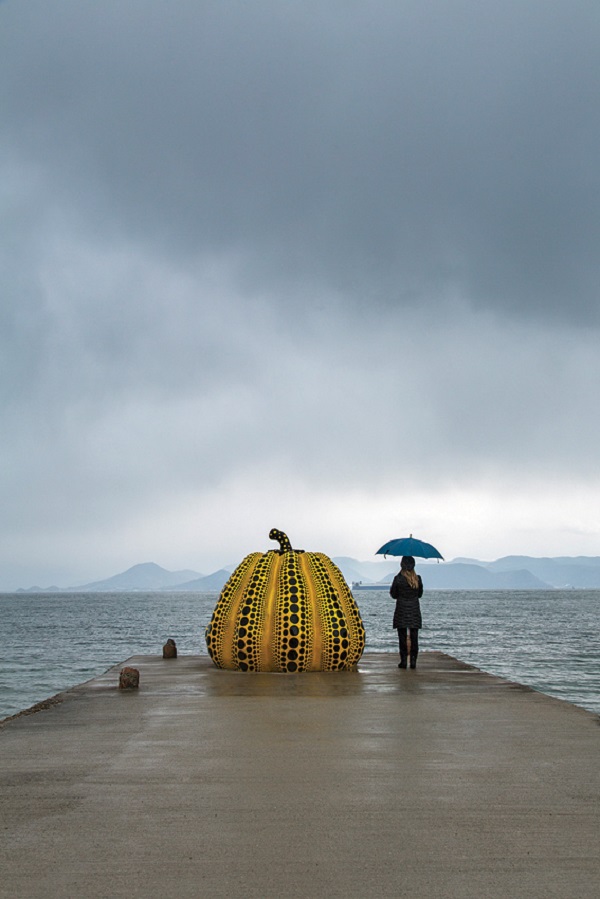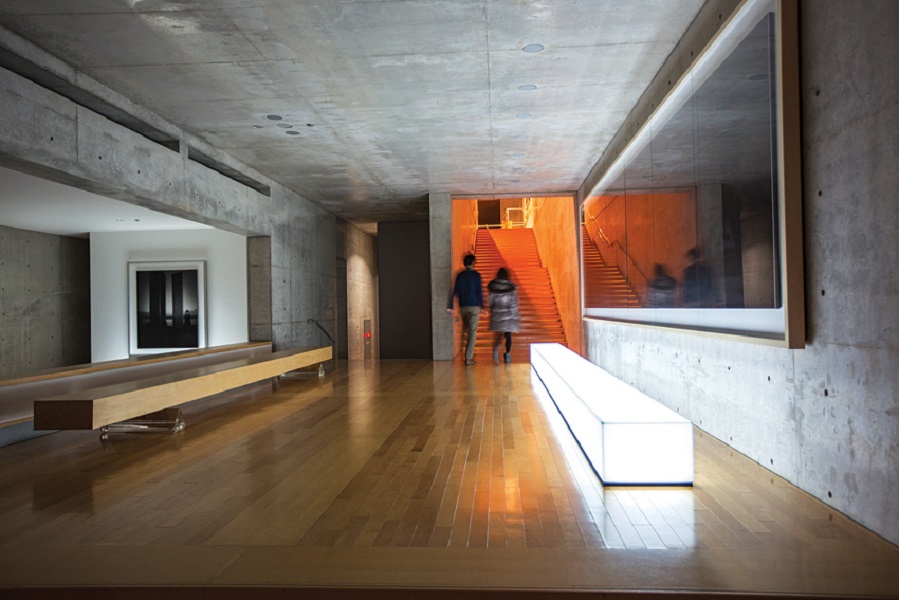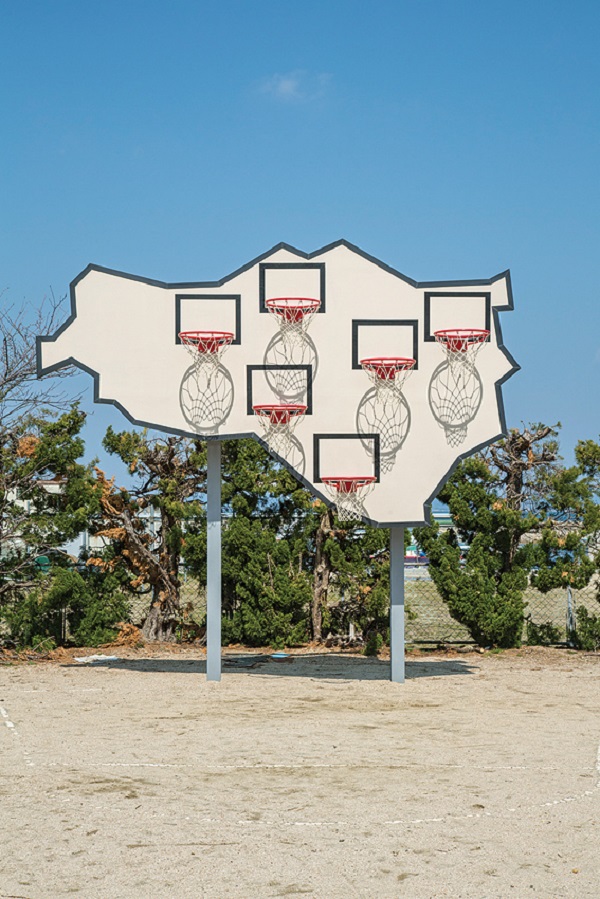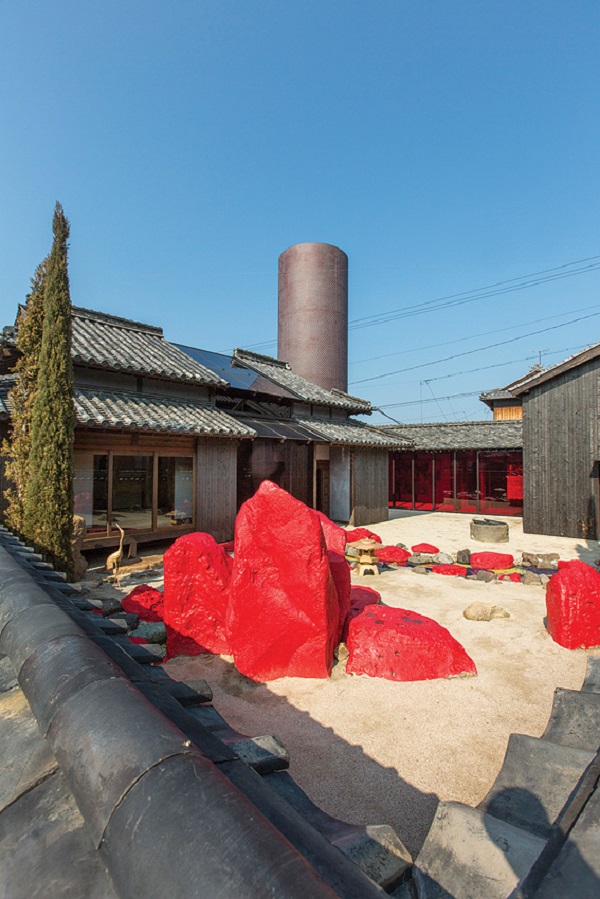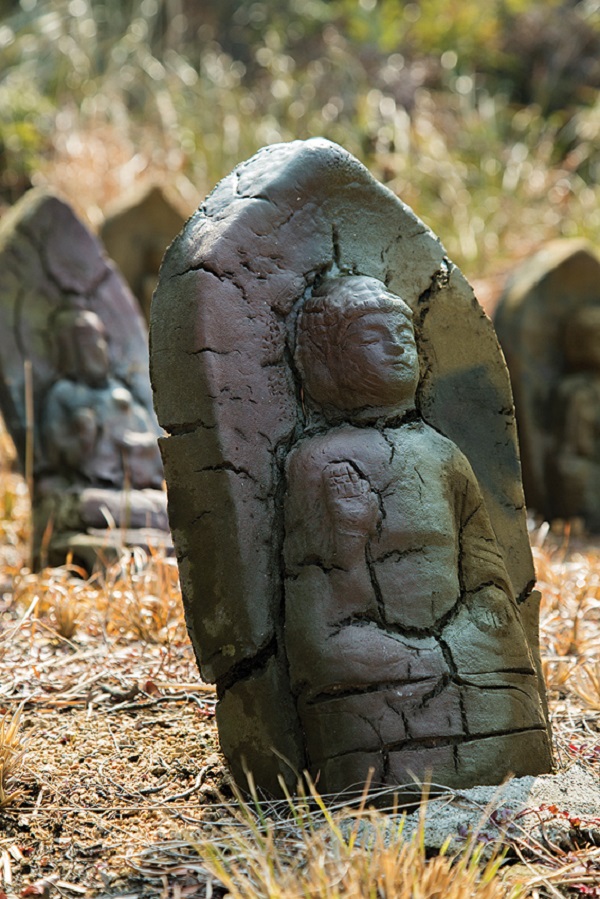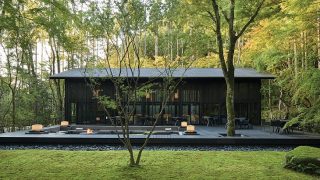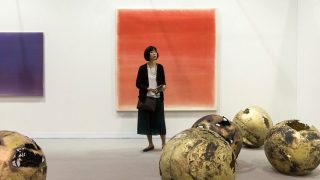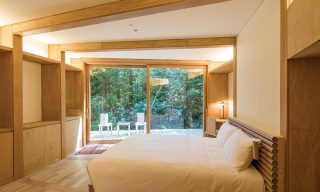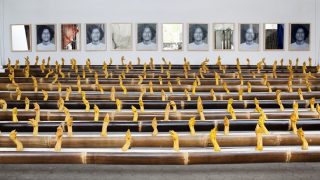I once visited a slightly mad old woman, a hermit, who lived in a low, elliptical cave that looked out across green barley fields to the starkly pinnacled hills of Upper Mustang in Nepal. Her cave was soot-black from countless cooking fires. She had no possessions save for a pot and some Buddhist talismans made of thread and beads. Tucked below a swatch of rebuilt rice terraces, the Teshima Art Museum brings her primitive dwelling unexpectedly to mind. Conceived by Pritzker Prize–winning architect Ryue Nishizawa and sculptor Rei Naito, the gleaming white teardrop-shaped dome suggests a cross between flying saucer and grotto, with two oval openings in its ceiling that cast circular pools of sunlight onto the smooth concrete floor and at times create a sort of wind tunnel, amplifying birdsong and breezes. It’s also a bold fusion of art, architecture, and nature designed to house Rei’s singular installation Matrix: through pinholes in the slightly sloped floor, tiny droplets of ground water bubble up, bead, wriggle, and trickle down to join larger puddles of water under the oculi.
I become transfixed by this aqueous ballet, and I’m not alone. There are at least 20 other people inside, and no one’s saying a word. One couple is holding hands, utterly silent, gazing downward, perhaps inward. Another lady is so overcome that she sits on the floor hugging her knees, quietly weeping. Like the Nepalese hermit woman in her cave, this meditative space `seems to express a common desire: deep longing for the utter reduction of sensation, so that in this unfettered emptiness one might “see the light.”
After a couple of nights at Benesse House we move to Tsutsuji-so, a well-kept hostel of Japanese cottages, yurt-style tents, and camper accommodations that’s just a five-minute walk up the beach. Though I miss my sleek, Ando-designed room and elegant kaiseki dinners at Benesse, it doesn’t take long to succumb the simpler pleasures of Tsutsuji-so. Our cottage’s spare, square tatami room is just steps from the beach with sliding shoji screens that transmit the soothing sounds of the waves. Making up the futons feels like playing house; I position them on the tatami, layered with soft comforters, and we sleep like kittens—but not before the cafeteria overwhelms us with a huge platter of sublimely fresh rockfish, prawns, scallops, squid, and vegetables, which we cook by turns in a pot of boiling miso broth at the table.
In the morning we catch a bus that takes us a couple kilometers north to the old fishing village of Honmura, the island’s second-largest settlement. This is where Benesse kicked off its Art House Project program back in 1998, inviting a number of Japanese artists to transform old disused buildings into showcases of contemporary art. If Chichu is the heart of Benesse, these are its nerve endings. There are presently seven such venues, all of which you can tour in a few hours, crowds permitting. Among them are Kadoya, a restored 200-year-old house that features three artworks by Tatsuo Miyajima (my particular favorite is Sea of Time ’98, a darkened room with blinking LED counters afloat in a shallow pool of water); Ishibashi, the onetime residence of a rich salt merchant, now home to a pair of gorgeous paintings by Hiroshi Senju; and Go’o Jinja, an Edo-era shrine sporting an optical glass staircase by Hiroshi Sugimoto.
The elderly people we meet on foot or bicycle are lively, friendly, and seemingly proud of their transformed island. My ever-gregarious husband strikes up a conversation with a beautiful woman, possibly in her 80s, swinging her feet off the wooden porch of a hostel on a narrow street leading to one of the Art House Project sites. She starts talking in rapid Japanese to Macduff. Not missing a beat he replies in rapid English, and this conversation goes on for several minutes interspersed with laughter and smiles. He swears they communicated just fine. I don’t doubt it. Art is its own language, as is friendliness. Perhaps that’s the goal of any pilgrimage.
THE DETAILS
Getting There
Bullet trains from Kyoto or Osaka put you in Okayama in about 75 minutes, after which you can hop a train to Uno Port and catch one of the 16 daily ferries to Naoshima. Alternatively, fly into Takamatsu Airport on nearby Shikoku, the smallest of Japan’s four main islands. The prefectural capital of Kagawa, Takamatsu is connected to Hong Kong and Bangkok by flights via Taipei, and is also home to Ritsurin Garden, one of the most beautiful historical gardens in the country. High-speed passenger ferries cover the distance between Takamatsu Port and Naoshima in 25 minutes.
Where to Stay
For art and architecture enthusiasts, the Tadao Ando–designed Benesse House (81-87/ 892–3223; doubles from US$310) is a must. There are just 65 rooms spread across four distinct buildings: Park and Beach, both with views to the sea; Museum, located within the Benesse Art Museum, where you can walk into the galleries at midnight in your pajamas; and Oval, a hilltop annex accessed by a funicular and featuring six rooms with retractable glass walls that radiate out from a central pool.
Friendly lodgings with rates that are easier on the wallet can be found at Tsutsuji-so (81-87/892-2838; cottages from US$190). The café here turns out meals that are every bit as memorable as those at the nearby art site.
Resources
Visit the Benesse Art Site Naoshima website for extensive information about the site’s facilities and transportation links, including its art projects on Teshima and Inujima islands.
This article originally appeared in the June/July 2014 print issue of DestinAsian magazine (“Treasure Islands”).


